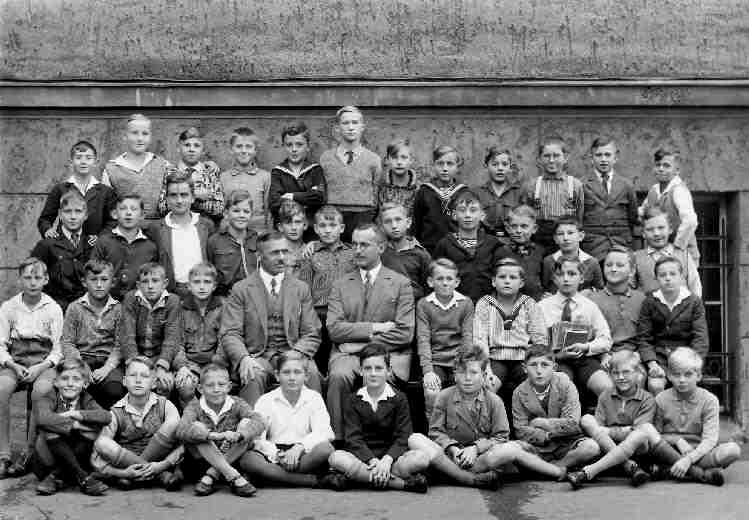The children here look about 11 years old. This is the age that children were separated with the more academically clever going to a secondary school. The less academically clever stayed in primary schools for a few more years. Theoretically this division was made on academic nility, but social class was a major factor, in part because of the parents and the extent they guided and assisted the children. Finances were another factor. There were fees associated with secondary schools and many working class families could use the wages a youth could earn. Thus most middle-class children attended secondary school while working-class children did not advance beyounf primary school.
We would gues that this is a class in the the first or second year of a secondary school. We are not sure why there are two teachers here. Perhaps there were two classes at this grade level. We have, however, seen many single class portraits that had this many children. We do not note many photographs of small classes. So it could be one class. Perhaps the second teacher is the headmaster. I'm not quite sure here.
Chronology
The children wear many common styles from the early 1930s. While the image is undated, we are fairly sure that it is an image from the Weimar era. Two of the boys wear youth uniforms--but we are not at all sure that that are Hitler Youth uniforms. A reader writes, "I think that you are correct that this photo is from the 1930s--both because of the length of the short pants and because most of the long stockings are beige or brown, although one boy apparently wears black long stockings. The light colors were more popular in the 1930s. Although dating it as to just when in the 30s is moe tricky. I'd say it definitely was the early or mid-30s." Another reader writes, "I think you are right as to the timing of this picture. I take that primarely from the looks of the teachers. The kid's clothing could have also been from the '40s. It is intersteing to see that some kids wore stockings and one of the kids rolled them down."
We see boys wearing just about ever garment and style that was popular in the 1930s except for caps and coats which they are not wearing. Here only a few boys are wearing suits which were more commn in the 1920s. A few boys wore suits or suit-like jackets, both with and without ties. As was very common in the 1920s, a few boys wear sailor suits. They are all traditionally styled suits.
Several boys wear sweaters. We notice many different patterns and styles. Some boys wear ties with their sweaters, but open collars are more common, although we see few Schiller collars. This was a major style in the 1920s. All of these boys seem to be wearing short pants, although we can't be sure about the boys in the back rows. Only a few boys wear suspenders or at least wear them so they can be seen.
One boy wears a h-bar halter. The boys wear both long stockings and kneesocks. They are all solid colors. We do not note any patterns. Nor do we see any boys wearing ankle socks. One boy has rolled doen his kneesocks. The boys here wear mostly low-cut oxfords. We also notice quite a number of boys wearing what look like soft strap shoes which seemed to have been worn rather like American boys wore sneakers. One boy wears a youth group uniform, we think a Scout uniform.
Youth Groups
Two boys wear youth group uniforms. We are unsure, however, just what group is involved.
We thought they might be Scouts. A reader writes, "As to the Scout Uniform: I am not certain that this was a scout uniform. It was tradition to wear a scarf and not a lanyard with the scout uniform.
Maybe it was a for-runner of the Hitler Youth." They could be Hitler Youth (HJ) uniforms, but notably neither boy wears a neckerchief with his youth group shirt. There were many different youth groups active in the early 1930s and the HJ was mot yet very large. I think wearing HJ uniforms to school before Hitler seized power would have been discouraged if not prohibited, but I m not entirely sure about that. Perhaps this is why the boys are wearing their youth organizatin shirts without the neckerchiefs which were more identified with the organization than the shirt.
Hair Styles
Note that none of the boys here have cropped hair, a style still fairly common in the 1920s. The boys here have hair that can be combed, although often cut very short on the sides--rather like A British short back and sides. Some of the boys have hair cut in bangs, but mostly not sharp bangs. Most have hair that is combed back in front in rther modern styles.
HBC

Related Chronolgy Pages in the Boys' Historical Web Site
[Main Chronology Page]
[The 1900s]
[The 1910s]
[The 1920s]
[The 1930s]
Navigate the German school pages
[Return to the Main German Weimar school garment chronological overview page]
[Main school uniform page]
[Main school uniform national page]
[Main German school uniform page]
[Imperial Germany]
[Weimar Republic]
[NAZI era]
[Post-war Years]
[Unified Germany]
Navigate the Relate Boys Historical Clothing Style Pages
[Main country page]
[Long pants suits]
[Short pants suits]
[Lederhosen]
[Kneesocks]
[Eton suits]
[Jacket and trousers]
[Blazer
[School sandals]
Navigate the Boys' Historical Clothing School Uniform Pages
[Main School Uniform Page]
[Australia]
[England]
[France]
[Germany]
[Italy]
[Japan]
[New Zealand]
[Scotland]
[United States]
Navigate the Boys' Historical Clothing Web Page
[Introduction]
[Activities]
[Biographies]
[Chronology]
[Cloth and textiles]
[Clothing styles]
[Countries]
[Topics]
[Bibliographies]
[Contributions]
[FAQs]
[Glossaries]
[Satellite sites]
[Tools]
[Boys' Clothing Home]
Created: 1:47 AM 8/2/2006
Last updated: 12:30 AM 8/3/2006




